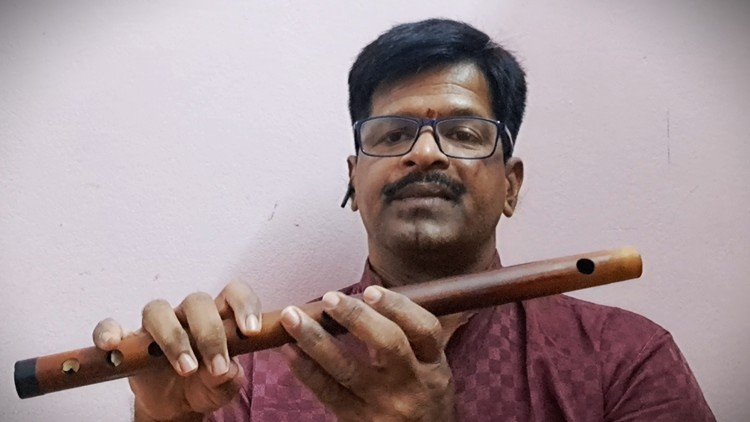Get the coupon in the end of description.
Description
Veena Kuppayyar (1798–1860) was an exponent of Veena and a composer of Carnatic music. He was a student of the famous composer Tyagaraja. Kuppayar composed his songs in Telugu language and has left behind a number of popular kritis.
Veena Kuppayya was born in a Telugu Brahmin family in Tiruvottiyur, near Chennai. His father Sambamoorti Sastri was a famous vocalist as well as a veena player. Kuppayyar had his initial training from his father. Later he continued his musical training under Tyagaraja and learnt the art of music composition from him. Following the steps of his guru, Kuppaiyer has composed two groups of Pancharathnams – Kālahasti Pancharathna kritis and Vénkatésha Pancharathna kritis. The Panchrathna kritis are in Telugu and bears his nom de plume “Gópāla-dāsa” – his family deity, Sri Venugopala Swamy. These Panchrathna kritis also have been bedecked with beautiful Chittaswarams – solfa passages.
Kuppayyar later moved to Chennai and sought the patronage of the local ruler Kovur Sundara Mudaliar. Kuppayyar trained a lot of disciples, who carried forward the legacy of Tyagaraja, helping to spread his krithis. Veena Kuppayar was a talented veena player. He also learnt the violin, a new instrument to Carnatic Music at that time. He composed many varnams and krithis in particular. The most famous varnam was Sami Ninne in Shankarabharanam. When he was in his height of composing, he received the title of Asthana Vidwan.
Kuppayyar was a talented composer and created several immortal songs which bear his mudra, ‘Venugopala’. He was also one of the earliest established artistes to make Madras his base. In the words of Professor P. Sambamoorthy, Kuppayyar was mainly responsible in making Madras a seat of music culture. The city, he opined, ought to be proud of Kuppayyar.
After living for a while at Tiruvottiyur when he was supported by the Rajahs of Kalahasti and Venkatagiri, Kuppayyar moved to George Town where he came under the patronage of Kovur Sundaresa Mudaliar, dubash of the East India Company. Kupayyar took up residence at 88 (now 33/10), Ramaswami Street. The house soon became famous for its musical soirees. Legend has it that when Tyagaraja visited Madras in the 1830s, he called at this house and composed a song here.
Kuppayyar’s youngest son was Tyagier. Chitra Pournami and Vinayaka Chaturthi were celebrated in a grand fashion by Tyagier in the house and many concerts were held during the festivals. Despite suffering from ill-health for most of his life, Tyagier taught many disciples. He also published two books on music — Pallavi Swarakalpavalli in 1900 and Sangita Ratnavali in 1907.
In 1904, the famed Hindustani maestro, Vishnu Narain Bhatkhande came to Madras and met Tyagier in this house. He was very impressed with Tyagier’s simplicity and erudition.
The residence was of the archetypal town-house pattern that Madras was famous for till the 1950s. Those who have been inside remember it as having all the standard elements, such as rezhi (hallway), mittam (courtyard) and the straight passage leading from the front door to the rear exit. The house remained in the possession of Tyagier’s family till the 1950s and then became the office of a TUCS branch, with the first floor serving as the manager’s residence, till the 1970s. It later became a wine shop for a short while. Subsequently, it was given over to the elements.
Hamsadhvani (meaning “the cry of the swan) is a rāga in Carnatic music (musical scale of Carnatic tradition of Indian classical music). It is an audava rāgam (or owdava rāga, meaning pentatonic scale). It is a janya rāga of the Melakartha raga, Sankarabharanam (29th) but according to Hamsadhvani’s prayoga or the way it is sung it is said to be the janya of Kalyani (65th).
Hamsadhvani is also extensively used in Hindustani music and is borrowed into it from Carnatic music. It was created by the Carnatic composer Ramaswami Dikshitar (1735–1817), father of Muthuswami Dikshitar (one of the musical trinity of Carnatic music), and brought into Hindustani music by Aman Ali Khan of the Bhendibazaar gharana. It has become popular due to Amir Khan.
Hamsadhvani does not contain madhyamam or dhaivatham. It is a pentatonic scale (audava-audava ragam[3][5] in Carnatic music classification – audava meaning ‘of 5’). Its ārohaṇa-avarohaṇa structure (ascending and descending scale) is as follows (see swaras in Carnatic music for details on below notation and terms):
The notes used in this scale are shadjam, chatushruti rishabham, antara gandharam, panchamam and kakali nishadam. In Hindustani music, it is associated with Bilaval thaat (equivalent of Shankarabharanam).


























